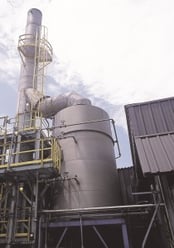Though dry dust collectors are the most popular form of air pollution control (APC), there is no single answer to today’s APC problems. In many
cases, a wet scrubber may work better than a baghouse, even for dry dust.
A wet scrubber is a device designed to remove a contaminant from an air stream using a scrubbing fluid or solution. The contaminants can be solids, liquids, or gases, and the solution is water-based and non-aqueous.
Some common contaminants wet scrubbers are most capable of removing include:
| Contaminant | Ideal contaminant size | Examples |
| Gases (molecular size) | <0.008 microns | Hydrochloric acid, sulfur dioxide |
| Fumes (solids particulate) | <1 micron | Metallurgical |
| Dust (solid particles) | >1 micron | Minerals, cement, flour, etc. |
| Mist (liquid particles) | .01-10 microns | Oil, acid, caustic, etc. |
| Droplets (liquid particles) | >10 microns | Sprays |
 If you are considering using a wet scrubber over a baghouse, consider the following situations in which a wet scrubber is clearly the best choice:
If you are considering using a wet scrubber over a baghouse, consider the following situations in which a wet scrubber is clearly the best choice:
1) The contaminant is not a particle. It may be gases such as sulfur dioxide, ammonia, or hydrochloric acid, or it may be odors or mists.
2) The particles are larger.
3) The gas stream to be cleaned is too hot.
4) The gas stream to be cleaned is too wet.
5) The dust is hygroscopic.
6) The pollutant is explosive or flammable.
In these situations, you may want to consider using a wet scrubber over a baghouse. However, every facility is different and requires a customized solution that works best for its operations.
For further questions or inquiries regarding a specific situation, give Sly a call at 866-721-3545. One of our trained representatives will be on hand to assist in finding the APC solution that works best for you.
Tags: dust collector, baghouse, Blog, wet scrubber



